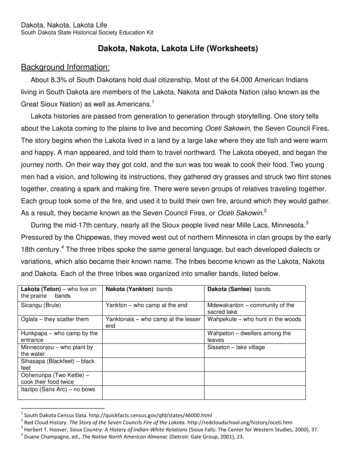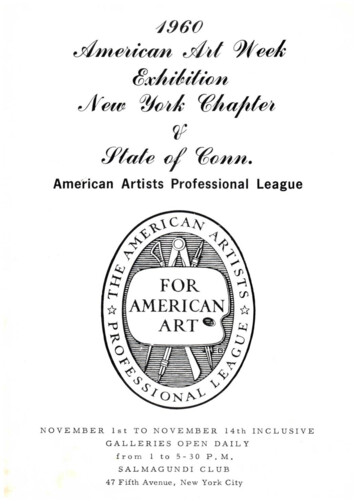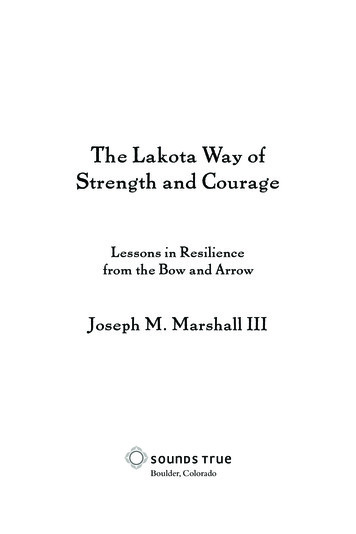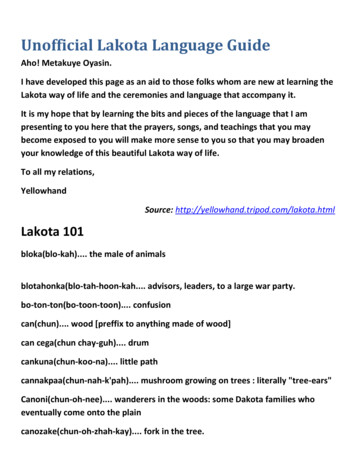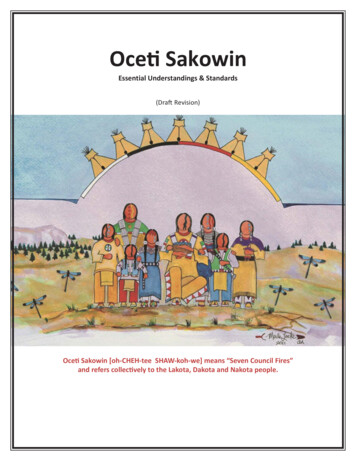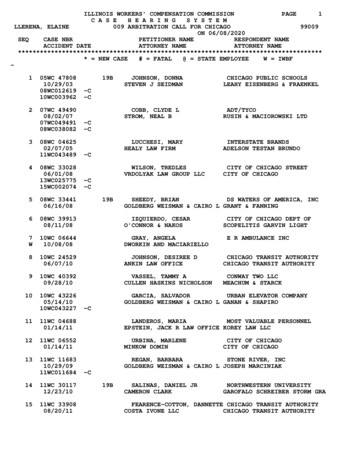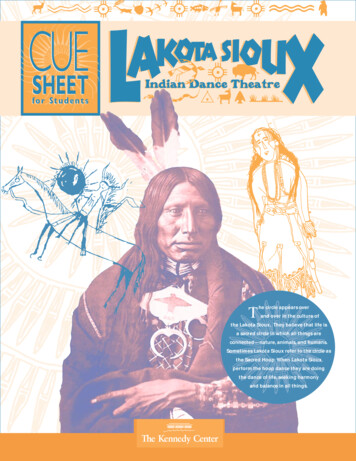
Transcription
he circle appears overTand over in the culture ofthe Lakota Sioux. They believe that life isa sacred circle in which all things areconnected—nature, animals, and humans.Sometimes Lakota Sioux refer to the circle asthe Sacred Hoop. When Lakota Siouxperform the hoop dance they are doingthe dance of life, seeking harmonyand balance in all things.
The Lakota Sioux:A Rich Historypublished by theNative Americans once lived throughout what is now the United States. In1492, when Columbus arrived in the Americas, there were about twomillion Native Americans living in 300 tribes.According to scientists, the ancestors of Native AmericansEducation Departmentcame to North America from Siberia at least 20,000of the John F. Kennedyyears ago.Welcome to Cuesheet,one of a series ofperformance guidesCenter for thePerforming Arts,Washington, D.C. ThisCuesheet is designed tobe used before andafter attending aperformance by theLakota Sioux IndianDance Theatre. You mayDuring the Ice Age, the sea level dropped, causing a landbridge to appear at the Bering Strait. Hunting buffalo and woollymammoth, they crossed the bridge. Native Americans believe theirancestors always lived on this continent.Large numbers of Native Americans lived on the Great Plains.The Siouxmigrated there in the 1600s.They had lived along the Mississippi River asfarmers and hunters in places that today are the states of Minnesota,Wisconsin, and Iowa.When they were defeated by their American Indianenemies and when white settlers seized their land, the Sioux haduse Cuesheet alone orto leave their farms and hunting grounds andwith others. Some of thewander in search of a new home.suggested activities in itwill be more interestingif they are done withclassmates, friends, orfamily members.nWhat’s inCuesheet?The Lakota Sioux: A Richreached the Great Plains and learned to leadnomadic lives, moving from placeto place in search of food.Farming, forests, and lakeswere forgotten as theSioux learned tolive in an“ocean ofgrass”.Eventually, theyColumbus madea mistake when hecalled the nativesof North America“los Indios.” Hebelieved that bysailing west fromEurope far enoughhe would arrivesomewhere in Asia.Like otherEuropeans, he didnot know that theAmericas existed.Because hethought he wassailing in the IndianOcean when helanded at SanSalvador Island inthe BahamaIslands, he calledthe people he met“los Indios.”History, page 2Spirits and Myths,page 5The GreatPlains covermore than 1,500,000square miles. Theterrain of theGreat Plains varies.It has vastgrasslands. It alsohas some ruggedhills, such as theBlack Hills, whichare the sacredceremonial groundsof the Sioux.of Life, page 6The Lakota SiouxIndian DanceTheatre, page 8Looking andListening, page 9Family, Community,and Nature’s Cycle,page 10The Buffalo: A ValuedFriend, page 12You May Want To.,page 122Photos cover & page 2: National Anthrolopogical Archives, Smithsonian InstitutionDances and the Circle
THE NAMES bywhich we knowNative Americantribes were given tothem by whiteexplorers andsettlers. TheChippewa calledthe Sioux“Nadewisue” (nayday-wee-soo), theword for “littlesnake,” meaning“enemy.” Frenchexplorers haddifficulty sayingthe name andshortened it to“Sioux.” The Siouxare composed ofthree principallanguage groupsliving in differentparts of the GreatPlains: Lakota,Dakota, andNakota. They allmean “the people.”RESERVATIONSare places setaside by federaland stategovernments forIndians to live on.There are about300 reservationslocated in 34states.The Sioux were one of the 30 tribes that lived on the Great Plains.Theysoon became fierce warriors and buffalo hunters. From 1830 until 1870,the Sioux were the most powerful PlainsIndians.Unfortunately, contact with white settlersbrought the Sioux great misery. Settlerstook the Sioux land and built fencesaround it to keep out other settlers and to prevent theSioux from reclaiming it.TheUnited States Governmentmade treaties withNative Americansguaranteeing their ownership ofland. Unfortunately, all thosetreaties were broken bythe Government. Many Sioux died of diseases like smallpox andmeasles, which the settlers brought with them and to which the Sioux werenot immune. Many Sioux died in battles with army troops sent tocontrol them. Like other Native Americans, they were forced to livein poverty on reservations.For the Sioux, the final devastating massacre of their people occurredin 1890 at the Battle of Wounded Knee, when almost 250 men, women,and children were killed by United States soldiers.The Lakota Sioux believethat the sacred circle of life was broken for them at thatbattle, and it is only in recent times that the circle is becoming whole again.3HERE ARE MANYTfascinatingdetails concerning theBattle of WoundedKnee. Research andexplain what role theGhost Dance played inthe battle, why thebattle happened, andwhat its results were.
The SacredPipe is the holiestof all objects forthe Sioux. Thewooden stem andpipestone bowlrepresent theAmerican Indian’sbody. The tobaccoin the bowlrepresents all livinggreen things. Thesmoke that comesfrom the pipe represents the breathof the people, andit carries prayers toWakan Tanka, theCreator.Part of theland takenillegally from theLakota Sioux is theBlack Hills of SouthDakota, theirsacred ceremonialgrounds. The tribesued the UnitedStates governmentfor the return ofthat part on whichno one lives. In 1980the Governmentadmitted it waswrong and offeredto pay millions ofdollars to the tribe.The Sioux refusedthe money andappealed the ruling.They want onlytheir sacred landreturned. By 1994no decision hadbeen reached.HE NAMES of manyTplaces in the Unitedoday, Lakota Sioux continue to live on reservations in North andSouth Dakota, Nebraska, Minnesota, and Montana. Some live inCanada. However, many Lakota Sioux live, as other Americans do,in urban communities throughout the country. Today,TStates have AmericanIndian names. Some ofthem are:Potomac (River),Manhattan,there are about 1,900,000 Native AmericansChicago,living in the United States.Appalachia,Since 1924, when Indians were recognized as American citizens, theirlives have gradually improved. But their strugglegoes on. New homes and roads are beingbuilt on reservations.There are newand better schools. Over 30 tribalcolleges and universitiesthroughout thecountry offerprograms whichinclude the studyof Native Americanheritage.More and more Americanand Mississippi.Indians are claimingIdentify places in thecity or state where youlive that have Indiannames. Find outwhat the namesmean. Make a smalldictionary of them.OME FAMOUSSLakota SiouxTheAmerican Indian Movement (AIM)and other reservation-basedorganizations have helped to bringabout change. “Self-determination,”by which Indians decide how theywill use the natural resources onthe reservations and make otherdecisions for themselves, hasbecome important.The Sioux are sharing more andmore of the pride they feel abouttheir heritage. Sioux legends andhistories have been collected andpublished. Old skills are usedagain.The Lakota Sioux IndianDance Theatre shares an ancientculture through rituals, songs, anddances presented to audiencesthroughout the world.their civil rights.leaders were ChiefSitting Bull, Chief RedCloud, Chief Black Elk,Chief Crazy Horse, andChief Spotted Tail. Findout why they areremembered. Alone orwith others, make abooklet in which youinclude theirbiographies andpictures. Donate yourbooklet to the schoollibrary or media center.Prayer to the Buffalo4
Spirits and MythsSpiritsregardthe eagle as themost powerful ofbirds. They alsobelieve that it hasimportantreligioussignificance.Becauseit can fly highenough to disappearbehind the clouds,the Sioux believethe eaglecommunicatesprayers to thegreat spirit, WakanTanka. The mostsacred featherscome from theeagle. Eaglefeathers are usedin war bonnets, andas part of dancecostumes.THE SIOUXThe Sioux pray to the Great Spirit, WakanTanka, who created the sacred circle of life onearth.They believe Wakan Tankagave power to all things.Photos by Sakari ViikaNative Americans believe that specialpowers were given to many differentanimal spirits, such as the eagle, deer, hawk,and buffalo. Many times animalspirits were called uponduring visionquests.A boyaround 12Eagle Danceyears ofage was carefully prepared by tribal elders anda medicine man to go on the first of many visionquests. He would go to a quiet and lonely place tofast, taking with him the sacred pipe.Through thevision quest he hoped to receive a message fromWakan Tanka and to gain wisdomand strength to help him be agood memberof thetribe,and tounderstand his place in the circle of life. If the boy had a vision, he told it tothe medicine man, who interpreted it for him.EAD SOME NativeRAmerican creationmyths, for example“The White Buffalo CalfWoman.” Choose onethat interests you mostand do one of thefollowing to retell it: ndraw a set of sequentialpictures n record it onaudiotape and share itwith your friends andfamily n act it out byyourself or with othersn create a dance thatexpresses its meaning.IND OUT MOREFabout the impor-tance of feathers to theLakota Sioux. What is a“coup”? Why wascounting coupsimportant to warriors?Make a set of drawingsarepeople who havereceived specialhealing power fromWakan Tanka.They are thespiritual leaders ofthe tribe.MEDICINE MENMythsshowing how feathersMyths are traditional stories passed along through oral tradition. Somemyths explain how things came to exist. Some myths tell about gods andheroes. Some myths tell why people and animals behave the way they do.Different groups of people tell different myths, but many of them aresimilar throughout the world.Lakota Sioux myths teach that humans are a tiny partof a large and mysterious universe. They also helpexplain the sacred circle of life. Prayer, expressed through ritual andceremony, is the way to make sure that life on earth is good.Among the responsibilities of the wise men of the tribe was to bekeepers of tribal memories, including myths.They were also responsible forpassing on how to perform rituals and ceremonies.were worn by the Sioux5to show their braveryand accomplishments inbattle.RITE A POEMWthat expressesthe respect LakotaSioux feel for the eagle.
The Hoop Dance celebrates the way ofDances and theCircle of Lifelife of all Native Americans. One legend says thatthe hoop dance is about the sacred circle of life.When a person does the hoop dance he isacknowledging the sacred circle and all the thingsthat are connected within it.Dance is a central part of the life of the LakotaSioux people.They dance to express their beliefin spirits, nature, and the relationship of all thingsto one another.They dance to share traditions.They dance to honor people.They dance in powwows to celebrate their culture. And they danceto enjoy themselves.Native American dancersdance in honor of WakanWhenthey dance to express their beliefs, to sharetraditions, or to honor people, all the members ofthe tribe are part of the dance. Even the peoplestanding around the circle in which the dancesare performed are part of it. Mothers may holdbabies, people may chat and gossip, buteveryone helps the dancers by praying andshouting approval and applauding. In that way,Tanka, the Great Spirit.all the members of the tribeparticipate in the dance.When the dancers perform in front ofaudiences in theaters, things are different.Thedancers are sharing their traditions with andtelling about their history to nontribal audiences.Since they perform on a stage rather thanin the sacred circle on their reservations, anarrator explains the dancesso that the audience will understand them.Whendances are performed for other Lakota Sioux,everyone understands their meaning becausethey have grown up participating in them.At the performance of theLakota Sioux Indian Dance Theatre, the narratorwill explain the meaning of each dance. He willalso discuss important ideas about the historyand beliefs of the Lakota Sioux.The dancers willsometimes sing while they dance. Somemembers will play the flute and drum.There aremany kinds of dances performed by the LakotaSioux Indian Dance Theatre. A few of them aredescribed on these pages.The Women’sShawl Dancerequires dancers toimprovise movement to unusuallyfast drum beats.Important in thedance are thewomen’s fringedshawls and beadedleggings and moccasins.The womenmove their arms toimitate eagles’wings.The Women’sShawl Dance is not atraditional dance. Itwas invented in the1940s and ’50s.The Women’s Traditional Dance honorswomen, who represent Mother Earth. In Lakota Sioux tradition,women are admired as the bringers of peace and harmony.6
The Grass Dance is also called The Grass Flattening Dance.The dancersflatten a grassy area where a special event takes place. In the past, those whoperformed the dance were admired because when they danced they cleansed andpurified the circle in which they danced.The movement, in combination with thesweetgrass on the dancers’ leggings, are an offering to the Earth Mother and to theGreat Spirit.Today, dancers wear yarn on their leggings instead of sweetgrass.The Buffalo Dance honorsthe animal that gave the Lakota Sioux food,shelter, and other means of survival.This dancewas originally performed by members of theBuffalo Society, all of whom had dreamed of thebuffalo in their vision quests.The Sneak Up Dance reenacts abattle.The dancers depict warriors stalking theirenemies.The Eagle Dance is a prayer to the Great Spirit.Thedancer asks for a blessing on the people as he imitates thesoaring of the eagle, a symbol of the Great Spirit.The whistle imitates the eagle’s cry.The Round Dance is one of the most significant dances in which menand women dance together. It is related to the hoop of the nation and the sacredcircle.The Round Dance is a friendship dance for all people to join in to completethe sacred circle of life and to help keep all things on earth in balance.7
The Lakota SiouxIndian DanceTheatreNarratorThe Lakota Sioux Indian Dance Theatre,produced by The Solaris Lakota Project, tours withapproximately 12 to 15 American Indians whoperform dances, songs, andceremonies that have been partof their culture for centuries.The Dance Theatre shares its work by travelingthroughout the world.The members of the company are eager for everyone to see thebeauty of their culture.The Lakota Sioux Indian Dance Theatrewas founded on the Rosebud Reservationin South Dakota in 1978. Henry Smith, theartistic director, worked closely with Siouxleaders, who helped him decide what dancesto perform and how to present them for bothIndian and nontribal audiences. Mr. Smith isnot an American Indian, but he has been sodevoted to learning about and sharing theculture through the dance of the Lakota Siouxthat he has been adopted by some tribal families.He became interested in Lakota Sioux dancetraditions when he was teaching dance in a schoolon a South Dakota reservation.The narrator is a respectedSometimes thenarration is provided by Albert White Hat, whohelped make the film “Dances With Wolves.”Sometimes it is provided by Lance White Magpie,a descendant of Chief Crazy Horse, or by MarianOne Star, a consultant on tribal customs.elder and storyteller.Above: Grass Dance.Right: Men’sTraditional Dance.Photos by Sakari ViikaThe musicians in the company are GabeDesRosiers, the lead singer of Northern Wind, agroup that performs at many powwows, and BrianAkipo, a traditional flute player. Lead dancers areMarian One Star, Jessie Spotted Tail, Grace HerMany Horses, Leon Thompson, Lance WhiteMagpie, and Lillian and Ron Good Eagle.8
Looking andListeningAttending a performance by the Lakota SiouxIndian Dance Theatre will be interesting andenjoyable for everyone if youremember.''''the dances allow us to experience something about the Lakota Sioux way of life.the dances are about such things as thesacred hoop, the buffalo, and the eagle.that the Lakota Sioux believe that dance is animportant part of the sacred circle of life.dance must be watched closely in order tosee the patterns of movement.watch.'''''REATE A DANCEhow the dancers use the space of the stage:one place or many; close together or farapart.how the dancers’ movements are usuallyclose to the ground.how the dancers start and stop exactly onthe beat.how the dancers show energy: fast, slow;calm, exciting.for objects such as eagle feather fans andhorse dance sticks.listen.'how the drumbeats fit the dances.' for the onespecial time in eachdance when four beatsare sounded loudly andthe dancers turn fourtimes. (The four beatsrepresent the fourdirections of the compass,which are part of the sacredcircle of life.)' for rhythms.' for singing.Round Dance9Cthat expressessomething you aregrateful for. Choosemusic that goes wellwith your dance.Practice the dance.Perform it for classmates, friends, or yourfamily. Explain tothem what you aregrateful for and why.MAGINE that youIare a dance critic fora newspaper ormagazine. Write a200-word review ofthe Lakota SiouxIndian Dance Theatre.Tell what dances wereperformed and whatthey mean. Offer youropinion about howwell they wereperformed and howthey made you feel.
Family, Community,and Nature’s CycleFamily StructureThe four mostimportanthumanqualities forMembers of the traditional Lakota Sioux tribe lived in close-knit families.The work of both men and women was necessary to the survival of thefamily. However, they had different responsibilities.Men fought and hunted.They were responsiblefor the ceremonies and rituals.They alsoprepared young men for their vision quests.Women raised the children and taughtthem the Four Great Virtues of Life.Women also grew crops, made tepeesand clothing, and cared for the sick.Families passed onthe LakotaSioux ere calledthe Four GreatVirtues of Life.Each virtue isconnected to theothers. All familymembers strivedfor worthiness ineach virtue.tribal beliefs andskills for survival.In this way, Lakota Sioux madesure that the circle of life wouldcontinue.HAT ARE FOURWIMPORTANTVIRTUES you want todevelop? Draw ashield divided intofour sections. Writeone quality in eachsection. Then draw apicture for eachquality that explainswhat the qualitymeans to you.Lakota Doll, 1880.Denver Art MuseumNational Anthrolopogical Archives, Smithsonian InstitutionCommunityThe Lakota Sioux community was made up of groups of manyfamilies. Each group was an extended familyof fathers, mothers, sisters, brothers, grandparents, cousins, uncles,and aunts. Men and women had different jobs, but they workedtogether for everyone’s benefit.10
Nature’sCycleTo NativeAmericans, theseasons werepart of thegreat circle ofThe Sioux did nottell time by the sun, as wedo, but by the moon.Theynamed the changing moons todescribe seasonal activities.Spring began in our month of April and wasknown as “Moon of the Birth of Buffalo Calves.” In the spring, families lefttheir winter camps and began gathering food and hunting, though theyallowed the buffalo to fatten until fall.Summer began in our month of June, which was known as “MoonWhen Strawberries Are Ripe.” At the beginning of summer, men went onvision quests to seek personal guardian spirits. Also in the summer, all theSioux tribes met and arranged their tepees in circles. For four days theypurified themselves. For the next four days they celebrated the sacred SunDance ceremony.Fall began in our month of August, which was known as “TheHarvest Moon.” It was the most important hunting season of the year.Themen killed enough buffalo for the meat to last through the long, frozenwinter.The women made pemmican from the meat.Winter began in our month of November, which wasknown as “The Winter Moon.” As the snow began to fall,families settled into winter campsites. Men and boys repairedtools while women and girls sewed, decorated clothing, andmade dolls. At night, stories were told around the tepeefire. Soon it would be spring, and the circle of seasonswould begin again.life.ispreserved deermeat that hasbeen flattenedand mixed withtallow (fat) anddried chokecherries. It issomewhat similar tomodern-day “beefjerky.”Pemmicanthe dwellingof the LakotaSioux. Tepees werealways placed in acircle. The wordtepee comes fromthe Sioux words “ti,”meaning “dwelling,”and “pi,” meaning“used for.”Tepee:11AKE A WALLMCALENDARusing the LakotaSioux names of themoons of the year.Illustrate what thenames mean. Markyour birthday and thebirthdays of yourfamily and friends.“A beautiful tepeeis like a good mother.She hugs her childrento her andprotects them fromheat and cold,snow and rain.”—Sioux proverb
The Buffalo:A Valued FriendMillions of buffalo roamed free on the Great Plains before the white settlersmoved west.The lives of the Lakota Sioux revolved around the hunt of thebuffalo.They honored the animal’s spirit and used all of its parts for theirsurvival.Between one and two hundred uses wereThe Sioux madetepees, blankets, clothes, ropes, shoes, and drumheads from buffalo skins.They made containers, such as cups and dishes, and gun-powder horns.Bones were used for needles. Because the Sioux did not make pottery, theyused dried buffalo stomachs to store water and as containers in which tocook. Before the Sioux had horses, they disguised themselves in buffaloskins that still had the heads attached when theyIND OUT MOREabout ways thehunted the buffalo.Women kept count of thebuffalo hides they prepared by carving small dots Sioux used the partsof the buffalo. Makeon the handles of the scrapers with which theyan illustrated chartdid their work.showing the uses andSome say there were as many as 12 millionbuffalo when settlers and gold prospectors arrived share it with yourclassmates.on the Great Plains.They destroyed the grass thebuffalo ate.They turned many parts of the Great Plains into grazing andfarm land.Worst of all, they killed millions of buffalo for sport. By1889, only 540 were still alive. Today, 15,000 buffalo livein protected areas. Some others live in national parks. Several thousand areraised on private ranches and are sold for food.found for the buffalo’s body parts.FYou may wantto read.Barron’s EducationalSeries, Inc., 1993.Brown, Dee. WoundedKnee, An Indian Historyof the American West.Adapted for YoungReaders by Amy Ehrlichfrom Dee Brown’s BuryMy Heart at WoundedKnee. New York: HenryHolt & Co., 1974.Taylor, Colin. The PlainsIndian. New York:Crescent Books, 1994.Campbell, Maria. Peopleof the Buffalo: How thePlains Indians Lived.Buffalo, New York: Firefly Books, Ltd., 1992.Erdoes, Richard. NativeAmericans: The Sioux.New York: Sterling Publishing Company, 1982.Hassrick, Royal B. TheSioux: Life and Customsof a Warrior Society.Norman, Oklahoma:University of OklahomaPress, 1967.Josephy, Jr., Alvin M. 500Nations, An IllustratedHistory of North American Indians. New York:Alfred A. Knopf, 1994.MacDonald, Fiona.Plains Indians. Hauppauge, New York:Weatherford, Jack.Indian Givers. New York:Ballantine Books, 1988.Wolfson, Evelyn. TheTeton Sioux: People ofthe Plains. Brookfield,Connecticut: The Millbrook Press, 1992.You may wantto see.Last Stand at Little BigHorn. “PBS: The American Experience” (60minutes), WGBH Educational Foundation(Boston) and Thirteen/WNET, 1992.Live and Remember (WoKiksuye), 1987; Fulfillingthe Vision (Oyate Iglukinipi), 1992; Come to theCenter and Dance (Cokata Upo), 1994; (30 minutes each), availablefrom Solaris LakotaProject, 264 West 19thStreet, New York, NY,10011.James D.Wolfensohn, ChairmanLawrence J.Wilker, PresidentDerek E. Gordon, Associate Managing Director, EducationLakota Sioux Indian Dance TheatreExecutive Editors: Lynne Silverstein and John C.Carr. Contributing Writers: John C. Carr, SherillBerryman-Miller, and Cynthia Word. Design: PaulDupree Communications. Special Thanks to: Henry Smith,artistic director, Lakota Sioux Indian Dance Theatre; Marian OneStar, Lakota Sioux cultural consultant and Lakota Sioux IndianDance Theatre member; Dr. Arnie Beauvais, Dean of Education andTribal Studies, Sinte Gleska University, Rosebud Reservation, SouthDakota; and Janet Starke.Cuesheet is funded in part through the support of the U.S.Department of Education, The Kennedy Center Corporate Fund, andThe Morris and Gwendolyn Cafritz Foundation. 1995 The John F.Kennedy Center for the Performing Arts12
the Lakota Sioux. They believe that life is a sacred circle in which all things are connected—nature, animals, and humans. Sometimes Lakota Sioux refer to the circle as the Sacred Hoop. When Lakota Sioux perform the hoop dance they are doing the
